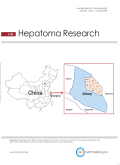- 钛学术文献服务平台 \
- 学术期刊 \
- 医药卫生期刊 \
- 肿瘤学期刊 \
- 肝癌研究(英文版)期刊 \
Genetics of alcohol-related hepatocellular carcinoma - its role in risk prediction
Genetics of alcohol-related hepatocellular carcinoma - its role in risk prediction
基本信息来源于合作网站,原文需代理用户跳转至来源网站获取
摘要:
Hepatocellular carcinoma (HCC) is the most common primary liver malignancy, with increasing incidence worldwide. Alcohol-related cirrhosis (AC) accounts for 30% of the global incidence of HCC and HCC-related deaths. With the decline of hepatitis C virus (HCV) and decreasing HCV-related HCC, AC will soon become the leading cause of HCC. Excess alcohol consumption (> 80 g per day for > 10 years) increases the risk of HCC by 5-fold. However, only up to 35% of excessive drinkers develop cirrhosis and its associated HCC risk. Individual variation in susceptibility to HCC is known, but there is limited information to predict who among the patients is at high risk of progressing to HCC. Clinical risk factors for HCC include male gender, older age, severity of cirrhosis, obesity and presence of type 2 diabetes. In addition to ethnic variability in HCC risk, genetic variants are known to alter the risk of alcohol-related HCC. For example, single nucleotide polymorphisms in PNPLA3 (rs738409, C>G) and TM6SF2 (rs58542926, C>T) increase the risk of AC-related HCC, whereas HSD17B13 (T>A) reduces the risk for HCC. Studies have also confirmed PNPLA3 and TM6SF2 to be independent risk factors for AC-related (but not HCV-related) HCC. Combining genetic risk factors with phenotypic/clinical risk factors has been explored for stratification of patients for HCC development. Risk allele rs378409-G in PNPLA3 when combined with phenotypic/clinical risk factors (BMI, age, sex) has enabled HCC risk stratification of AC patients into low-, intermediate- and high-risk subgroups. Similarly, a combination of the two genetic variants PNPLA3-G and TM6SF2-T has been independently associated with risk of HCC onset. Using a polygenic risk score approach of incorporating several genetic variants, prognostic performance of polygenic risk score that included PNPLA3 rs378409 and TM6SF2 rs58542926 improved HCC prediction better than with either variant alone. Incorporating new variants and risk factors has the potential to build better algorithms/models to predict onset, early diagnosis and treatments for AC-related HCC. However, clinical usefulness of these approaches is yet to be determined.

推荐文章
Metallogenic controls on the granite-related W–Sn deposits in the Hunan–Jiangxi region, China: evide
W–Sn deposits
South China
Zircon trace element chemistry
Ti-in-zircon thermometry
Oxygen fugacity
Spatial prediction of landslide susceptibility using GIS-based statistical and machine learning mode
Landslide susceptibility mapping
Statistical model
Machine learning model
Four cases
Geochemistry and petrology of rift-related mafic sills and arc-related Gabbro-Diorite bodies, Northe
Sills
Rizu formation
Rift
Volcanic arc
Ecological risk assessment of surficial sediment by heavy metals from a submerged archaeology harbor
Heavy metals
Eastern harbor
Enrichment factors
Degree of contamination
Potential ecological risk
内容分析
关键词云
关键词热度
相关文献总数
(/次)
(/年)
引文网络
引文网络
二级参考文献 (0)
共引文献 (0)
参考文献 (86)
节点文献
引证文献 (0)
同被引文献 (0)
二级引证文献 (0)
1985(1)
- 参考文献(1)
- 二级参考文献(0)
2000(1)
- 参考文献(1)
- 二级参考文献(0)
2001(1)
- 参考文献(1)
- 二级参考文献(0)
2002(1)
- 参考文献(1)
- 二级参考文献(0)
2003(2)
- 参考文献(2)
- 二级参考文献(0)
2004(2)
- 参考文献(2)
- 二级参考文献(0)
2005(1)
- 参考文献(1)
- 二级参考文献(0)
2006(5)
- 参考文献(5)
- 二级参考文献(0)
2007(1)
- 参考文献(1)
- 二级参考文献(0)
2008(1)
- 参考文献(1)
- 二级参考文献(0)
2009(1)
- 参考文献(1)
- 二级参考文献(0)
2010(2)
- 参考文献(2)
- 二级参考文献(0)
2011(5)
- 参考文献(5)
- 二级参考文献(0)
2012(5)
- 参考文献(5)
- 二级参考文献(0)
2013(3)
- 参考文献(3)
- 二级参考文献(0)
2014(1)
- 参考文献(1)
- 二级参考文献(0)
2015(4)
- 参考文献(4)
- 二级参考文献(0)
2016(9)
- 参考文献(9)
- 二级参考文献(0)
2017(7)
- 参考文献(7)
- 二级参考文献(0)
2018(14)
- 参考文献(14)
- 二级参考文献(0)
2019(15)
- 参考文献(15)
- 二级参考文献(0)
2020(4)
- 参考文献(4)
- 二级参考文献(0)
2020(4)
- 参考文献(4)
- 二级参考文献(0)
- 引证文献(0)
- 二级引证文献(0)
引文网络交叉学科
相关学者/机构
期刊影响力
肝癌研究(英文版)
主办单位:
出版周期:
月刊
ISSN:
2394-5079
CN:
开本:
出版地:
陕西省西安市高新区绿地SOHO B座1705室
邮发代号:
创刊时间:
语种:
eng
出版文献量(篇)
353
总下载数(次)
0
期刊文献
相关文献
推荐文献
- 期刊分类
- 期刊(年)
- 期刊(期)
- 期刊推荐
肝癌研究(英文版)2022
肝癌研究(英文版)2021
肝癌研究(英文版)2020
肝癌研究(英文版)2019
肝癌研究(英文版)2018
肝癌研究(英文版)2017
肝癌研究(英文版)2016
肝癌研究(英文版)2015
肝癌研究(英文版)2020年第9期
肝癌研究(英文版)2020年第8期
肝癌研究(英文版)2020年第7期
肝癌研究(英文版)2020年第6期
肝癌研究(英文版)2020年第5期
肝癌研究(英文版)2020年第4期
肝癌研究(英文版)2020年第3期
肝癌研究(英文版)2020年第2期
肝癌研究(英文版)2020年第12期
肝癌研究(英文版)2020年第11期
肝癌研究(英文版)2020年第10期
肝癌研究(英文版)2020年第1期

 免费查重
免费查重










